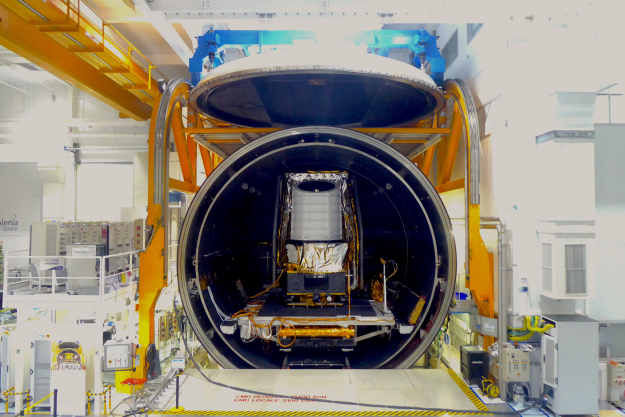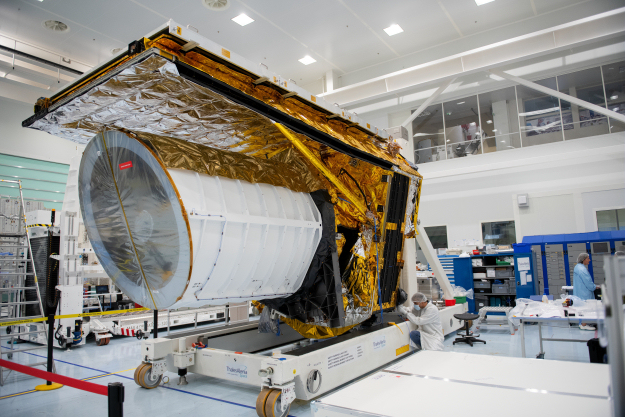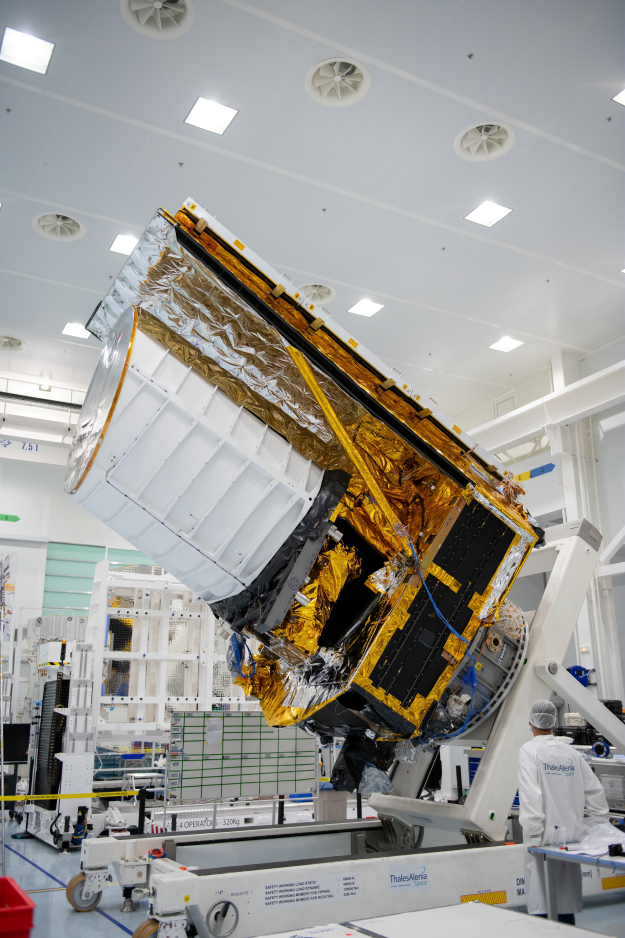#1: Euclid completes thermal-vacuum balance tests
10 October 2019
This is the first entry in the Euclid Test Campaign Journal, a series of articles covering the main events during testing of the Structural and Thermal Model (STM) and Flight Model (FM) of the spacecraft. The mission, scheduled for launch in 2022, will map the geometry of the Universe and improve our understanding of the mysterious dark matter and dark energy that make up most of the energy budget of the cosmos. |
| The structural and thermal model of the Euclid satellite in the thermal-vacuum chamber at Thales Alenia Space in Cannes, France. Credit: Thales Alenia Space/Airbus DS |
The gravity of dark matter – which makes up the majority of matter in the Universe – causes tiny distortions of the images of distant galaxies via an effect known as gravitational lensing. To map the large-scale distribution of dark matter in the Universe, scientists are planning to measure the distortions of more than a billion background galaxies – something that can only be done with a telescope that provides extremely accurate images of these galaxies.
The telescope on ESA's Euclid space mission can achieve an image quality that is close to the theoretical best limit for an optical instrument. Once in space, Euclid will not have to deal with Earth's atmosphere blurring the images; besides, there will be no deformations of the telescope caused by Earth's gravity.
 |
| Structural and thermal model of the Euclid satellite. Credit: ESA–S. Corvaja |
The only image distortions could be caused by temperature variations in the telescope structure due to varying amounts of sunlight received by the spacecraft while taking images of different parts of the sky. To assess the impact of such variations, a satellite model was built which has nearly identical structural and thermal properties to those of the flight model – the actual spacecraft that will be launched into space.
This Structural and Thermal Model (STM) was integrated in near-flight configuration in May, and completed its thermal balance test in September at the Thales Alenia Space facilities in Cannes, France. This was an important step in the lengthy process that will lead eventually to the verification of the spacecraft's performance before launch.
 |
| Structural and thermal model of the Euclid satellite. Credit: ESA–S. Corvaja |
Some of the elements composing the STM are identical to the flight counterparts and they will be retained as spares for the spacecraft once the STM campaign is completed. One important advantage of the STM is that, being a copy, it can be submitted to temperatures and mechanical stresses that are even more extreme than those expected in flight, therefore achieving qualification of the spacecraft design.
The objective of the thermal balance test was to verify the capability of the spacecraft's thermo-mechanical design to maintain all elements of the spacecraft at the intended temperature throughout the mission.
The data collected during the thermal balance test are used to fine-tune the mathematical thermal model of the spacecraft to increase its fidelity. Once updated, the thermal model will be used to predict more accurately the temperatures of all spacecraft parts and to forecast the environmental conditions of the telescope system in detail. This mathematical thermal model is very complex because it depends on a large number of design assumptions.
Thanks to the recently completed thermal balance test, the design assumptions are verified by direct measurements that enable engineers to learn about the thermal properties of the STM. In particular, key data are generated to characterise the insulation properties of the thermal multi-layer insulation blankets used to control the spacecraft temperature, as well as the effect of the heat generated by dissipating units, the heat rejection capability of radiators, and the performance of the heat pipes.
During this test, the STM was installed inside a large thermal-vacuum chamber in Cannes. The interior of this chamber is lined with black, cryogenically cooled shrouds to simulate the cold conditions that the spacecraft will experience once in space. Heated plates simulated the radiation input that will occur on the spacecraft surfaces that will be exposed to the Sun in flight.
 |
| Structural and thermal model in thermal-vacuum chamber. Credit: Thales Alenia Space/Airbus DS |
The test simulated extreme combinations of equipment usage, inclinations with respect to sunlight and solar intensities that exceeded those expected during the mission. During the different test cases, all important internal heat flow paths and external radiative surfaces were exercised and the satellite's temperature responses were recorded in almost 700 locations for later analyses, simulating and demonstrating its capability to maintain the thermal stability in these conditions.
The thermal design of Euclid should provide a very stable and cold thermal environment for the telescope and its instruments. The low temperature will be achieved by passive cooling, together with the right combination of heaters and radiators. The temperature stability of the optical system is extremely stringent and must be maintained during operations, including the cases where the telescope has to change its pointing, resulting in a change in the solar illumination of the satellite.
Across all conditions, the allowed maximum temperature variations within the telescope are of the order of a few thousandth of a Kelvin. To verify this, two dedicated tests were performed to calibrate the mathematical thermal model with sufficient accuracy.
A test replicating the exact flight conditions would cause temperature variations too small to obtain sufficiently precise measurement. Instead, an alternative test was carefully designed to verify that the mathematical thermal model could reliably predict the tiny temperature changes that would occur when the system is perturbed.
The test achieved this by amplifying the thermal disturbances to obtain measurable temperature variations in the telescope and comparing those variations with the predictions of the mathematical thermal model. Preliminary comparisons between the test measurements and model predictions indicate that the demanding temperature stability requirements will be met, achieving a very important milestone in the performance verification of the Euclid design.
The next step for the STM will be mechanical vibration tests. Meanwhile, integration and testing of the flight model of the Euclid telescope and service module have already started at the premises of Airbus in Toulouse, France, and Thales Alenia Space in Turin, Italy, respectively. The two modules will be integrated in 2021, and the complete satellite will then undergo final tests in preparation for launch.
About Euclid
Euclid will survey billions of galaxies with unprecedented sharpness and sensitivity during a nominal mission period of six years.
Euclid is an ESA medium class astronomy and astrophysics space mission. ESA selected Thales Alenia Space as mission prime contractor for the construction of the satellite and its Service Module, with Airbus Defence and Space chosen to develop the Payload Module, including the telescope.
The Euclid Consortium (EC) is a collaboration of nationally funded institutes responsible for the scientific mission, including the scientific instruments and data processing.
The Euclid satellite is scheduled for launch on a Soyuz rocket from Kourou, French Guiana, in June 2022.








